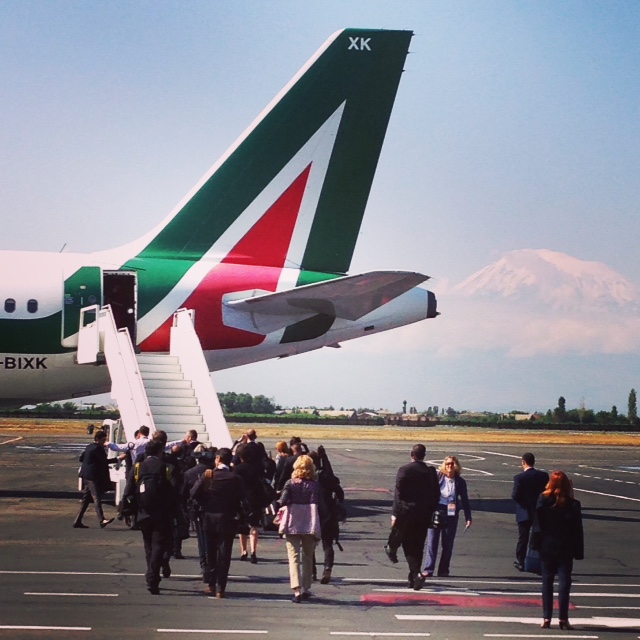
Dear Blog Readers,
This post is going to be a behind-the-scenes photo album of the trip to Armenia with the Pope because it is too late to fill you in on all the news.
On Friday morning I got up at 5am to get ready to head for the airport and the first thing I did was check my phone – big news, the “leave” vote had won in Britain and Brexit was to become a reality. I was shocked and dismayed and figured that no one would pay any attention anymore to the Pope’s trip to Armenia. I was partially right. For the entire three days we were in Armenia, Brexit dominated the news, however, there is still enormous interest in this Pope and when I turned on my TV late at night in the hotel in Yerevan I saw reports on the trip on French TV and on CNN.
Flying to Armenia the Pope came back and gave us a brief comment on Brexit saying he had just heard the news and the British people had expressed their will. He was a bit vague. He also expressed his happiness over the peace accords between the Colombian government and the FARC guerrillas. He then went around and greeted all of us journalists.
I was unexpectedly struck by the beauty of Armenia: the rolling green hills, the green plains dotted with colorful flowers and the rocky outcroppings.
Armenia was the first country to make Christianity its state religion back in 301 A.D. and it is a fact that they are proud of. There were banners along the road reminding us, it was in their speeches, documents and on the lips of many of the Armenians I spoke to.
During my time there I made friends with Narine Movsesyan, a 26-year-old Armenian woman who works as an attaché in the Armenian Foreign Ministry. This lovely young woman was assigned to accompany the Vatican press corps. She has a long ash-blond braid and clear blue eyes and is passionate about her career as a diplomat. She was always eager and available to give me a hand carrying my heavy equipment or provide me with information like the exact date when the Turkish government closed down the border with Armenia. “You must specify that they did that unilaterally,” she told me, or providing me with clarifications on the tensions in the Nagorno-Karabakh region.
“You know Armenia became the first Christian state in 301,” Narine said to me on the press bus as we headed to the Khor Virap monastery on my last day. “Of course I know,” I replied, “it is written everywhere!”
The Pope’s first stop was Etchmiadzin, a city 18 kilometers outside the capital that is the Holy City of the Armenian Apostolic Church – sort of an Armenia Apostolic Vatican City where their leader Patriarch Catholicos Karekin II lives. He was hosting Pope Francis at this residence. While the two religious leaders held a brief prayer ceremony in the Cathedral there, I was literally sweating buckets outside trying to transmit the Pope’s comments from the plane.
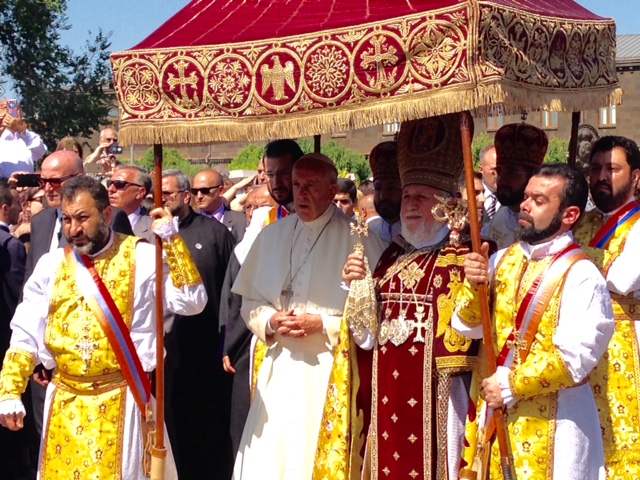
My super AP Television colleague Sophiko Medgrelidze from our bureau in Tbilisi, Georgia, who was coordinating the AP TV coverage of the Pope’s visit, had sent me the Armenian Mifi to Rome ahead of time so that I would be able to transmit as soon as I landed. The local phone company is called Beeline, and I was trying to get my Beeline Mifi to work. Nothing doing. Beeline was not going to help me out so then I had to try to use my personal hotspot on my Italian cell.
Dragging the tripod and my computer bag, I perched myself on the end of a park bench where three old Armenian men were chatting and trying to relax in the intense heat. I think they were mystified by my behavior as I sat there with my computer frantically turning the Mifi on and off, fidgeting with my phone, trying to get this video file to London. I could hear them chatting quietly and chuckling a little. I must have seemed ridiculous to them – absolutely frantic, soaking in sweat and relentlessly attempting to make the thing work. In the end it took me about two hours to send 3 minutes of video!
From there we were off to the President’s residence for a meeting with the Pope and the President, the diplomatic corps and the Armenian authorities. There had been some doubt about whether the Pope would again use the word “genocide” in his speech there. (See earlier blog posts “The Weight of a Word” and “Pope Francis heads to Armenia”)
The word “genocide” was not in the prepared text, but Pope Francis is not one to hold back and added it in this sentence. “Sadly, that tragedy, that genocide, was the first of the deplorable series of catastrophes of the past century” I was at the Presidential palace covering the speech and his audience there remained silent, but my colleague Sophiko, who was working in the press center, said a loud cheer erupted when he said that word. The Pope told us on the plane flying back to Rome that he learned the word “genocide” from Armenian friends when he was growing up in Argentina and for him that is the one to use for describing the slaughter. He repeated that for him it was the first genocide of the 20th century followed by the Holocaust and Stalin’s mass killings.
For the record, here is AP’s version:
“Historians estimate that up to 1.5 million Armenians were killed by Ottoman Turks around the time of World War I, an event widely viewed by genocide scholars as the first genocide of the 20th century. Turkey however denies that the deaths constituted genocide, saying the toll has been inflated, and that those killed were victims of civil war and unrest.”
It was not long before Turkey responded to the Pope’s choice of words. Turkey’s deputy foreign minister accused the Pope of having a “crusader mentality.”
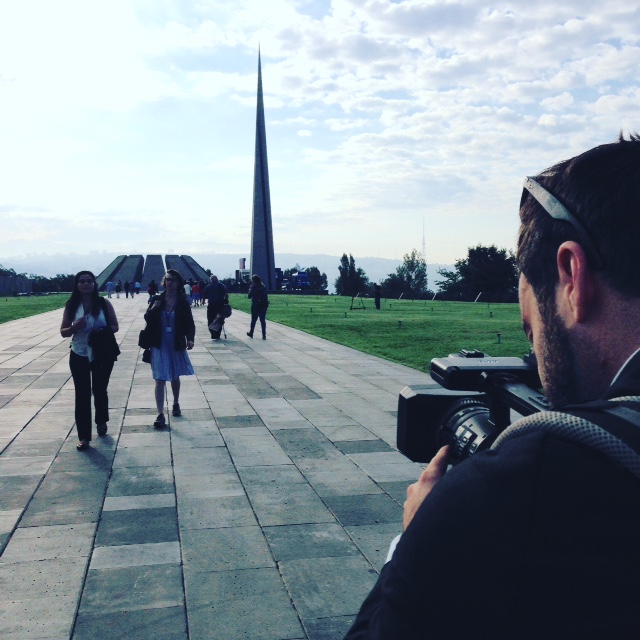
The Armenian genocide was to be a major theme of our second day as the first stop of the morning was the genocide memorial known as Tzitzernakaberd. The memorial is made of 12 massive sloping stones that surround an eternal flame.
Pope Francis made his way past Armenian soldiers in Soviet-looking sauce-pan hats down to the memorial.
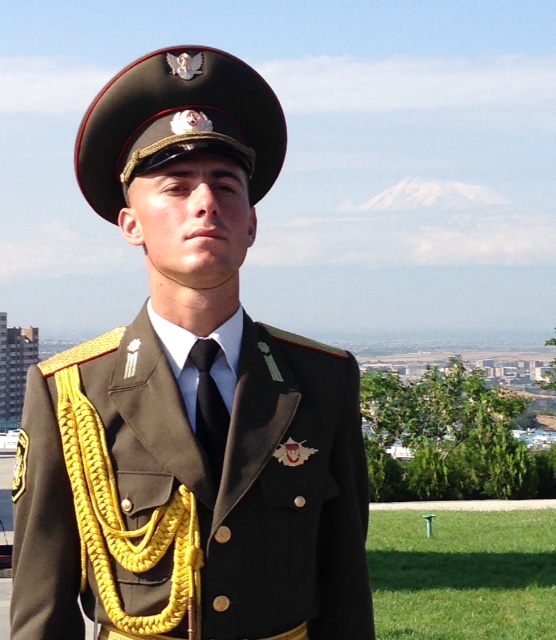
Children who are descendants of orphans taken in by the Vatican during the genocide lined the Pope’s path as he walked towards the memorial. The Vatican under Pope Benedict XV and Pope Pius XI hosted 400 Armenian orphans in Castel Gandolfo, the Papal summer residence near Rome.
As we stood watching him arrive, we had a splendid view of Mt. Ararat in the distance.
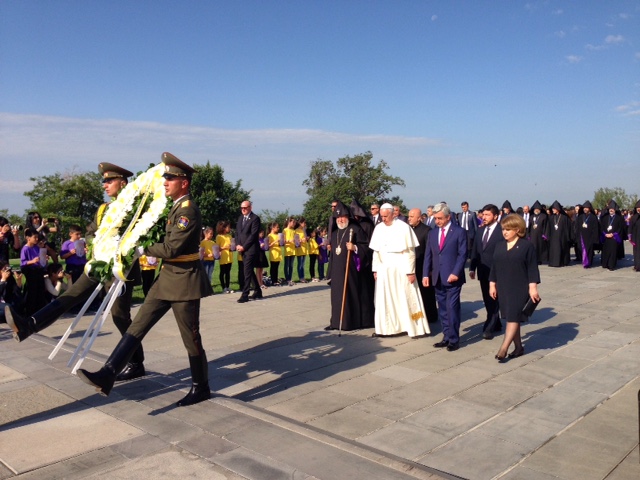
While the Pope was praying by the eternal flame in the memorial site, we were whisked off to the airport to get on the Papal plane for Gyumri, a small town in the northwest of the country. The plane took off and the Alitalia hostesses in their new uniforms had just enough time to run up and down the aisles a few times handing out drinks, Cristiana Caricato of TV2000 had just enough time to complete her full, on-camera make-up job (you should have seen her eyes when she was done!), I managed to pop off a few tweets and Instagram photos (love doing that when we are flying low, ssshhh, don’t tell) and then we were landing.
Gyumri is a small city in the northwest of Armenia that was completely destroyed by an earthquake in 1988. In Gyumri the Pope presided over an outdoor mass packed with thousands of Armenian faithful.
In the afternoon AP Television cameraman Pietro De Cristofaro and I were in a tight pool of photographers and TVs that remained in Gyumri while the rest of the press corps went back to Yerevan. We were allowed to accompany the Pope on his visits to two churches in the town.
The first was the Seven Wounds Armenian Apostolic Cathedral. During the period that Armenia was part of the Soviet Union (1922-1991), all the churches in Gyumri were closed with the exception of the Seven Wounds Cathedral. The Cathedral was badly damaged by the 1988 earthquake that destroyed mosh of Gyumri but restored by contributions from Armenians living in Argentina.
We were brought to the Seven Wounds Cathedral well before the Pope was to arrive and I had time to wander around and meet some people. Up a tight staircase in the gallery I met Hripsime Baldjian who said she had been playing organ in the cathedral for decades and was so pleased to be able to play for Pope Francis.
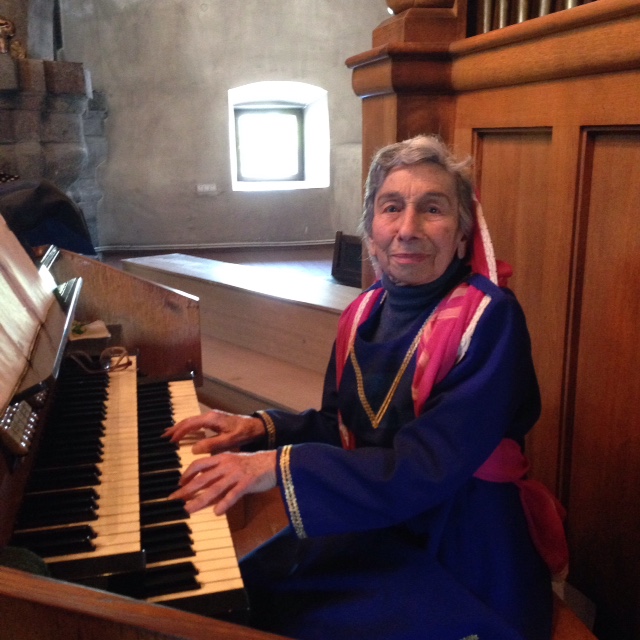
I then started chatting with the choir whose members asked me to film a video of them singing for the Pope.
Catholic News Service photographer Paul Haring got the below photo of me standing near the choir and posted it on Instagram with such kind words that I am copying them in the caption below.
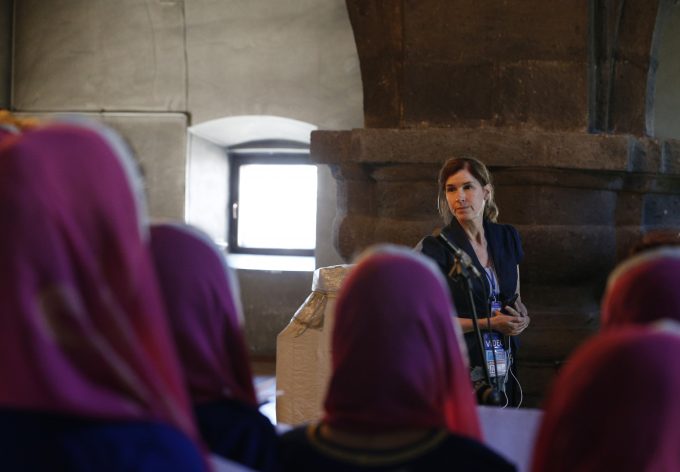
juxtaposed with choir members before Pope Francis’ visit to the Armenian Apostolic Cathedral in Gyumri, Armenia, June 25. The AP’s Trisha Thomas is always on the lookout for interesting stories, whether that be a global news figure such as the pope or a woman in the choir who has played the organ in the cathedral for 48 years. (Photo by Paul Haring)
Down below a found I bunch of elderly women waiting patiently to catch a glimpse of the Pope. Often on Papal trip we are blocked in the Papal entourage, on buses with the Vatican press corps, in the press center, and in the hotel at night so we do not get much chance to interact with the local people. This was a brief moment to do that.
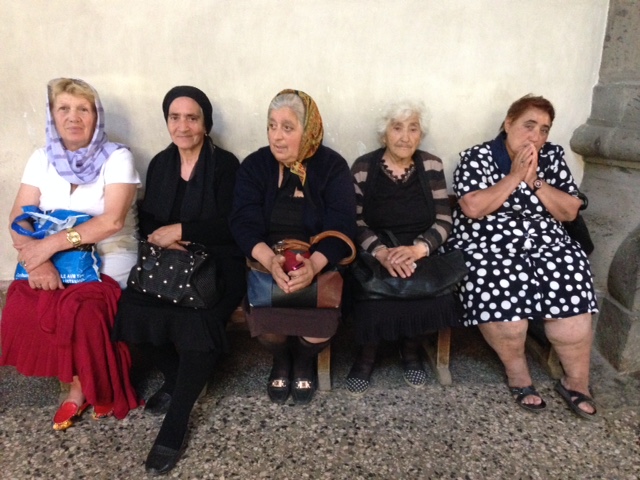
The last stop of the trip was the Khor Virap monastery on the Armenian-Turkish border.
Turkey closed the border in 1993 during a period of intense warfare between Armenia and Azerbaijan over the Nagorno-Karabakh region. There are long-simmering tensions between Christian Armenians and predominantly Muslim Azeris living in Nagorno-Karabakh. Tens of thousands died in the fighting in the early nineties before a cease-fire was signed in 1994 without any resolution on the status of the region.
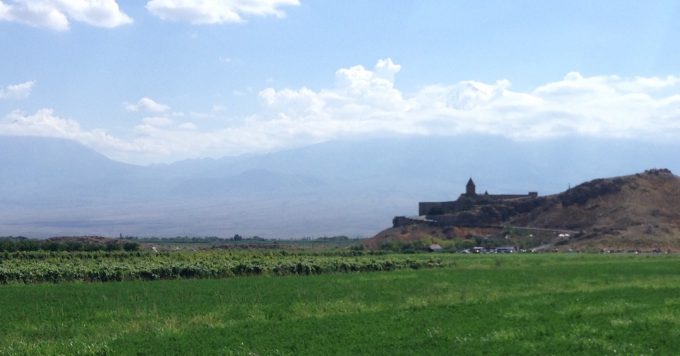
The two sides have been separated by a demilitarized buffer zone but fighting broke out again in April this year with a total of 75 people killed on both sides.
According to information provided by the Armenian Ministry of Foreign Affairs, from 1989 to 1994 the Khor Virap monastery was a gathering place for volunteers heading to battle in the Nagorno-Karabakh area.
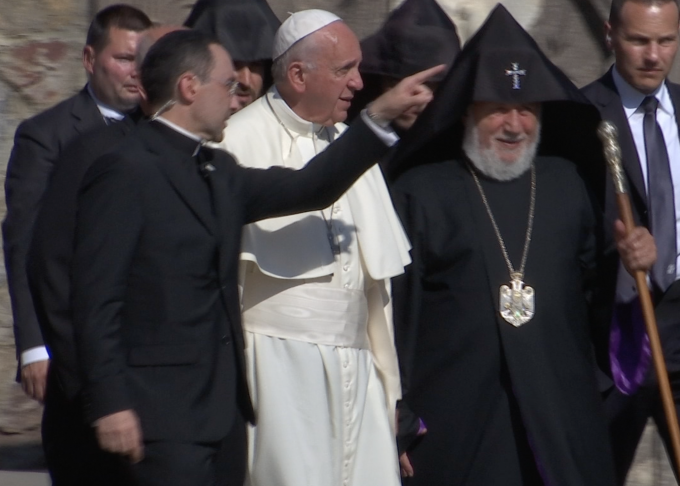
The Pope made the historic monastery of Khor Virap on the plain below Mt. Ararat the last stop on his visit. Legend holds that Noah’s ark landed on the slopes of Mr. Ararat.
Khor Virap, which means “deep prison”, is built on the site of a pit where the Armenian king Tiridates threw the Christian Gregory into prison and kept him there for over 10 years. Tiridates later released Gregory, converted to Christianity and in 301 Christianity was declared the state religion of Armenia. Saint Gregory the Illuminator is the patron saint of Armenia.
Again, I was in the tight pool of TVs and photographers who were taken to the site. We had about 45 minutes in the sweltering heat to check out the place I peered down the steep ladder into the pit where Saint Gregory was held and decided I would rather not check that out in person.
I had a fun time with Aura Vistas Miguel, the Vatican correspondent for Radio Renascenca in Portugal getting photos of a custodian at the monastery with fabulous mustaches that looked like they belonged in another century.
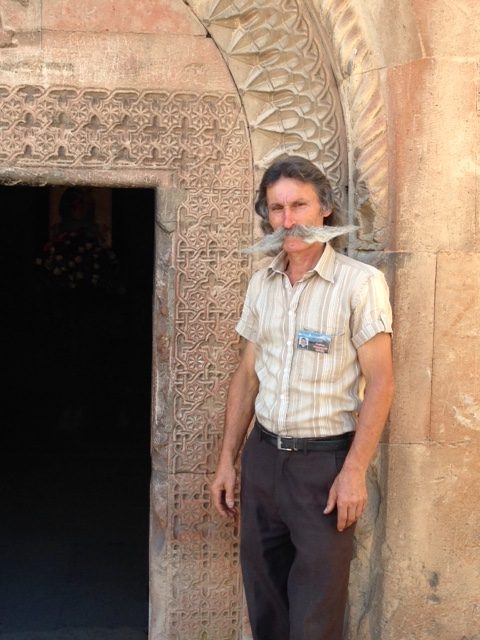
Pietro and I even had time to get a shot of the doves in their cage waiting for their moment in the limelight.
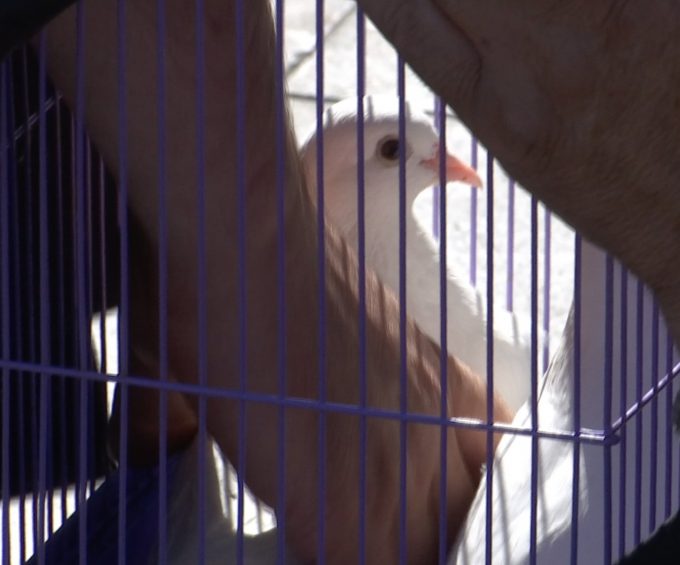
Then the Pope arrived and it was a rush of activity as we filmed him walking through the courtyard carrying a candle and visiting the chapel with Saint Gregory’s pit. While he was inside we rushed into position for the dove release moment.
When the Apostolic Priest in his black hooded robe was bringing the doves to the Pope and Catholicos Karekin II, the Pope glanced over at the small group of photographers, camerapersons, and journalists standing in the sun, I realized that we must have looked silly. I was wearing a safari hat and was using a selfie-stick to get a better photo of the moment. I giggled and I swear the Pope looked at me and gave me a huge smile. Then he turned and accepted the dove. The two men launched the birds towards the border and once again we were being rushed out. We had to jump off a wall and run for the van. As soon as we were in the van I popped open my computer, Pietro handed me the mini P2 card from the camera and I frantically edited as our van careened, racing down back roads and swerving around other vehicles as we got closer to the city. The driver was rushing to the airport in Yerevan trying to get us there ahead of the Pope. A half hour later we arrived, my edit was complete, I handed my memory stick with the story to Narine to take to Sophiko in the press center and headed for the plane. Editing video on a computer in the back of an air-conditionless mini-van in 37 degree heat (98 Fahrenheit) veering around other vehicles on the back roads of Armenia can have side effects. My stomach was up in the air and I felt dreadful. No time to think about that though. We had to prepare for the Pope’s press conference as we winged our way back to Rome. Preparing meets trying to open a camera tripod in between seats on the airplane and dragging a audio cable under rows of airplane seats to a Vatican-provide mult-box.
There is so much to say about the Pope’s press conference. It was over an hour and he went on at length about Brexit, genocide, homosexuality, his next trip to Poland, the Emeritus Pope Benedict XVI and other topics. Once again I had to open my computer and frantically edit trying to get the right soundbites edited and translated so I could transmit the material shortly after landing. Luckily no careening mini-van, just a little turbulence.
Sylvia Poggioli of National Public Radio was sitting behind me and we struggled with how to translate the Pope’s comments that Europe needs to face Brexit with “creativita’ e fecondita’’” – directly translated that would be “creativity and fecundity” – but in English fecundity means “fertility” and “reproduction.” I opted for regeneration. AP Vatican corresdpondent Nicole Winfield was sticking with fecunidty. In the final Vatican official translation the word choice was “fruitfulness” — yes, that works. There was also a debate among reporters about the Pope calling homosexuality “a condition” in Italian and how to appropriately translate that. I won’t share all the debate, instead here is a link to a transcription of the press conference.
TRANSCRIPT OF POPE’S PRESS CONFERENCE ON PAPAL PLANE RETURNING FROM ARMENIA
It is difficult for me–and everyone else– to pick and choose between all the good soundbites in such a wide-ranging press conference. I did a long edit, nearly six minutes, with bites on Brexit, Homosexuality, Benedict XVI and Genocide. Later, as if often the case, my desk came back to me with more requests — what about his comment on the “Balkanization of Europe”, what about the shot of the grimace the Pope made when someone mentioned the shooting in Orlando, Florida, what about where he said the Church must ask forgives to the poor, women who are exploited and children who are exploited for labor?
There is usually a two hour embargo and then as soon as it is lifted a great tweet-contest begins as all the journalists try to be the first to tweet the news from the press conference. It is all sort of silly…I can imagine those Armenian men on the park bench in Etchmiadzin shaking their heads and chuckling.
********************************************************************************
I received an email from Danielle Gilson in Chile saying the following:
1. Armenian Grape leaf dolma
Dolma is made of minced meat, chopped onions, rice, different types of spices all mixed together. Later the stuffing is rolled up in grape leaves. (Dolma may also be made with cabbage leaves – especially for vegetarian dolma served during the Easter Fast.
Canned grape leaves into boiled water, and as soon as they change their color – become brownish – we immediately take them out of the water.
To prepare grape leaves dolma, use one kilo of minced meat, and if you want to make it buttery, add some 200 grams of pork fat. Add one cup of washed round rice to one kilo of meat. The meat mixes with the colours of the dish, the onion, white rice, one tablespoon of tomato paste, 150 grams butter, black pepper and cayenne (depending on taste), and one tablespoon salt. Add dried basil, savory, dill, parsley and coriander to the taste. Fresh parsley, coriander and dill are on the cutting board. Grape leaves dolma is a very respectable dish in Armenian families. Armenian housewives usually decorate New Year festive tables with this dish, serving to special guests. Dolma rolled up in fresh young grape leaves is especially tasty. Now it is the best period to prepare this dish.
The following ingredients are necessary to prepare grape leaves dolma:
1 kg minced meat (you may also add 200 grams pork fat)
3 onions
1 cup round rice
150 g butter
1 tablespoon tomato paste
1 tablespoon salt
black pepper and cayenne (depending on taste)
greens – basil, savory, parsley, coriander, dill
1 kg grape leaves
How to prepare grape leaves dolma:
Take 1 kg minced meat, add 3 minced or chopped onions, 1 cup of round rice, 150 grams butter, 1 tablespoon tomato paste, and 1 tablespoon salt, black pepper and cayenne, depending on taste. Add some dried basil, savory, and chopped coriander, parsley, and dill to the meat. Add half a cup of warmish water to the mass and knead until well mixed. Leave the meat to “rest” for a few minutes. Open grape leaves carefully, put one teaspoon of stuffing on it and roll up cigar-like. After putting some grape leaves on the bottom of the pan, arrange dolmas on them, add some water to cover dolmas, add two teaspoons of oil and put the pan on a gas fire. In 20 minutes, dolma is ready. Dolma is usually ready when the rice has been thoroughly cooked.
2. Armenian bread lavash (Inscribed in 2014 on the Representative List of the Intangible Cultural Heritage of Humanity/ UNESCO)
Lavash is traditional thin bread that forms an integral part of Armenian cuisine. Its preparation is typically undertaken by a small group of women, and requires great effort, coordination, experience and special skills. A simple dough made of wheat flour and water is kneaded and formed into balls, which are then rolled into thin layers and stretched over a special oval cushion that is then slapped against the wall of a traditional conical clay oven. After thirty seconds to a minute, the baked bread is pulled from the oven wall. Lavash is commonly served rolled around local cheeses, greens or meats, and can be preserved for up to six months. It plays a ritual role in weddings, where it is placed on the shoulders of newlyweds to bring fertility and prosperity. The group work in baking lavash strengthens family, community and social ties. Young girls usually act as aides in the process, gradually becoming more involved as they gain experience. Men are also involved through the practices of making cushions and building ovens, and pass on their skills to students and apprentices as a necessary step in preserving the vitality and viability of lavash making. / http://www.unesco.org/culture/ich/en/RL/lavash-the-preparation-meaning-and-appearance-of-traditional-bread-as-an-expression-of-culture-in-armenia-00985
3. Armenian trout
Trout is one of the most tasty and healthy kinds of fish. Dieting experts recommend eating trout at least once per week. This fish contains Omega-3 acids, healthy fats and well-balanced proteins, so it’s perfect for nutritious breakfast, tasty lunch or scrumptious dinner.
Apart from that, Armenian apricots are the tastiest apricots in the world. And it was a natural idea to combine two authentic Armenian products and cook a masterpiece of them.
Trout is rather simple to cook. The most important is to preserve its tender flavour and texture. Trout can be salted, smoked, baked, fried, boiled, minced and freezed. There is a vast field for experiments with flavours, ways of serving, side dishes and sauces.
4. Armenian wine
Armenia is one of the oldest wine producing regions of the world.
Since ancient days Armenia was famous for the wine makers where original traditions were kept until this day. It is possible to learn about this even from works of such philosophers, as Herodotus and Strabo. In 401-400 BC, when the Greek armies led by Xenophon “were passed” on the country Nairi (one of the most ancient names of Armenia), in the Armenian houses they were treated with wine and beer which was kept in deep dugouts in special “karases”. It’s interesting, that in karases with beer have been inserted reeds which served for our ancestors as saltcellars. Archaeological excavations carried out by academic Pyatrovski in the 19th and 20th centuries have confirmed that in the 9th century BC, Armenia was a wine-making state. Archaeologists have found, in the fortress Teyshebaini, a wine storehouse with 480 karases (clay pots), which hold 37 thousand decalitres of wine. During excavation in Karmir Blur (one of the most ancient settlements of Armenia where first attributes of life are found out a little thousand years ago) and Erebuni (city-fortress in territory of presentYerevan, build 2800 years ago and become in 2700 the capital of Armenia) had been found 10 wine storehouses in which were 200 karases. Still ancestors ofArmenians – inhabitants of one of the most ancient states of the world – Urartu, were engaged in wine growing.
Thank you Narine!!!
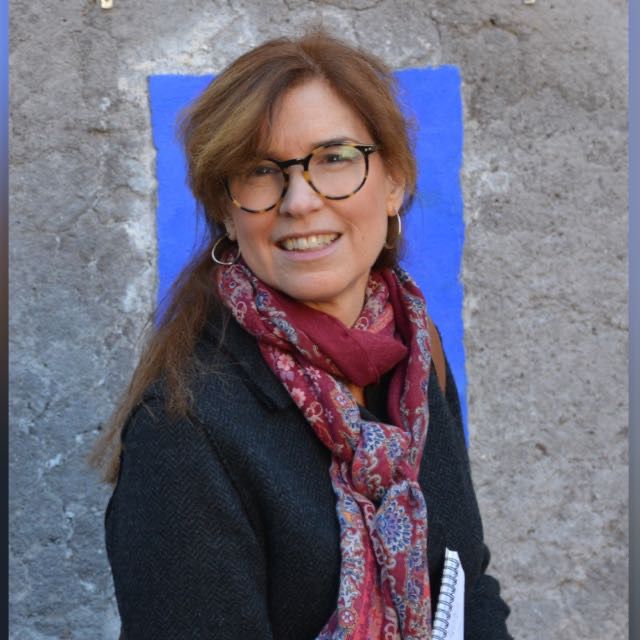
Great read, Trisha. So many interesting insights not just into the Pope’s trip but also into your job as a journalist–the good and the hard, the fun and the not so. The compliment with the photo in the cathedral is well deserved. It’s great that you manage to notice and know the people around you. Great pictures too.
Mille gratzie, a presto, Joan
Oh, thank you Joan. I don’t know why but I was really wiped out after the Armenia trip, which was much shorter that the Cuba-US trip and the Mexico trip, but for some reason very tiring. I almost threw in the towel on doing a post but reading your comment makes me glad I decided to go ahead and do it. Grazie!
Such interesting details! Thanks so much. I admire all of you, and especially the Pope, for working in such heat, and he in all those heavy robes. I simply could not, would have passed out. Grueling occupations, Pope and journalist. He did get a canopy, but still must have sweltered in all those clothes! Hope you all get a break now –
PS. Brexit is so stunning, and not over yet it seems, I am waiting, hoping they will somehow find a way to turn this around, as there is so much news of gross misleading of the public about how Leave could fill their coffers and keep immigrants out, all of which are now admitted to be false. We’ll see.
Brexit is terrible and I think David Cameron will go down as one of the worst British Prime Ministers in history pushing for a referendum on such an important decision not just for Britain but for the rest of Europe and with an indirect impact on the rest of the world. Shameful really.
Wonderful behind the scenes post Trisha. I have a good friend who is Armenian and travels to Yeravan a few times a year to work on humanitarian projects there, so I’m very interested in your piece. I’ll pass it on to her. I am continally amazed at your ability to cover these stories – in the heat, with time pressure, and equipment to connect, etc. I don’t know how you find the time and energy to also produce these insightful blog posts, with great photos and stories. But I’m glad you do it with such fecundità!
Thank you Linda!! Keeping up all this “fecondita'” at my age is starting to be a bit difficult! I am glad you take the time to read my posts — it makes it all worth it. Baci
It really was very hot and I don’t think it was easy for the Pope either. I am at a slight advantage because, as I have mentioned in other posts, my husband, like many Italians, is fiercely opposed to air-conditioning, so I have gotten used to dealing with pretty intense heat and no AC. That said, it is hard though when you are out in the sun for long periods, dressed in black and carrying heavy equipment. At least the Pope gets to wear white! I am amazed at his energy though — we all are — and are wondering how much longer he can keep it up. He is going to World Youth Day in Krakow this month, then in September to Georgia and Azerbaijan (I hope to go on that trip) and then to Sweden in October. Phew, get tired for him just thinking about it.
I saw a photo of the Pope sitting on an Alitalia plane in the bulkhead row. There was a gold ground painting hanging on the bulkhead wall. Do they put art from the Vatican collection on the plane when he is flying? I was so intrigued by that as I work for a museum.
Hi Kelly — how strange. I never noticed that — although the journalists never get to go up to where the Pope sits, he comes back to us. I will ask and let you know though.
I wish I could remember what article I was reading!
I am still waiting for someone at the Vatican to tell me what it was, but they said it was NOT from the Vatican museums. Will let you know.